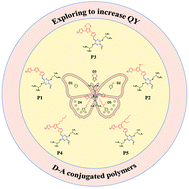A design strategy for D–A conjugated polymers for NIR-II fluorescence imaging†
Abstract
The development of bioimaging technology in recent years has shown that second near-infrared (NIR-II) fluorescence imaging (FI) is gradually replacing the traditional visible light and first near-infrared (NIR-I) FI. In the NIR-II window, the light absorption, autofluorescence and scattering of biological tissues are significantly reduced, which strongly promotes the design, development and application of contrast agents with NIR-II emission capabilities. However, the NIR-II bioimaging technology is still incomplete, in the initial stage, and has high research value. In order to increase the quantum yield (QY) of D–A polymers, we used thiophene, 3-methoxythiophene, 3,4-ethylenedioxythiophene (EDOT), 3-hexylthiophene and 3-(2-ethylhexyl)thiophene as strong electron donors and designed and synthesized NIR-II organic polymers P1, P2, P3, P4 and P5, which are of great significance to the molecular design of D–A conjugated polymers. Finally, we explored the FI of the polymers in vivo and in vitro, and verified our idea of increasing the QY.



 Please wait while we load your content...
Please wait while we load your content...